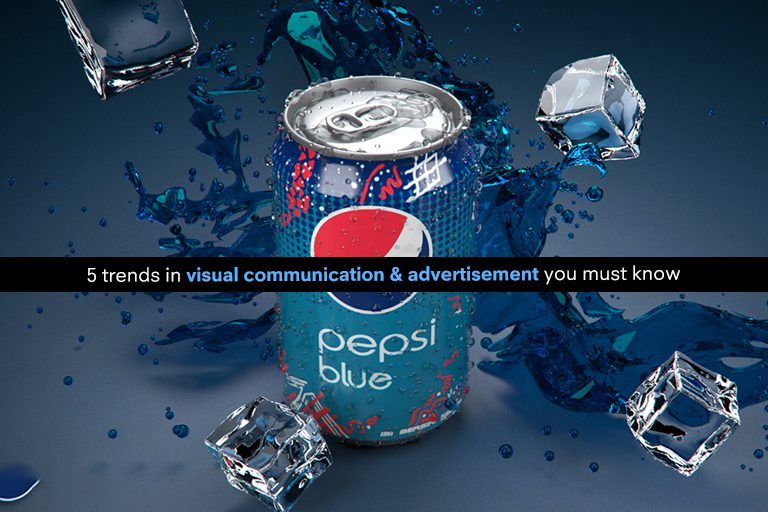Good visuals empower a brand to educate, inform and persuade their audiences through their striking use of imagery, color, typography and form. Visual communication landscape is one that is constantly evolving, shaping new trends and has a rapidly changing design style. What works in one country or culture may not be the best for another. This tells us that brands to fully reap the benefits from their ads and visual communication, they must continually flex and align with the latest design trends while keeping track of what their customers want.
Visual communication via the graphics has an effect on the consumers’ ability to use your product/ website or how they engage with your content and products. A great visual design will only help you enhance your appearance, build trust and goodwill with your community and create a loyal customer base. As a result, businesses tend to gain higher visibility, and it becomes easy for them to convince consumers about the quality and benefits of the products.
Also read: How Netflix creates immersive UX design
With this article, we aim to bring forward some key trends in visual communication and ads that you must keep an eye on as a designer and a brand that relies heavily on social media and general communication channels with your consumers.
Let’s get started:
1. 3D Design
3D design has been causing ripples in the graphic and visual design community for a few years now. It is everywhere and has established itself as the most popular design trend to capture.
Designers can now create 3D masterpieces that help them to showcase new dimensions of a product and overall environment for it. It has become easy to recreate the world with 3D elements that immerse viewers into depths. AR/VR gaming is one fine example of how the gaming sector has embraced this and became one of their core business strategies.
What started with the gaming sector, slowly became an ad world wonder and one of the prime ways to sell unique and immersive experiences by making the best possible use of AR/VR tech and offering 3D experiences to customers.
3D typography is another example that is no longer in the novelty space. 3D Typography works with almost every font, and the best part of it is that it is now easy to render any font in 3D. Slowly as it turns into realism, 3D design is expected to unlock infinite possibilities for visual communication and especially for the ad world. Metaverse, a visual world – built on 3D design – will help shape the world of 3D with even more precision and detail than we can possibly imagine.
If you want your consumer to not be able to take their eyes off your website, or merchandise, then start using 3D design in your typography and designs.
Also read: The myths of UX design
2. Videos ads are getting shorter, authentic and more crisp
In our world of social media, we already consume a variety of short videos every single day. This is how our world today is engaging with brands, getting their news, updating their applications and buying new products/ services.
Ad firms have become aware that the majority of their content should mainly be short-form video with crisp content since the consumers today have little patience for long haul videos. 10-15 seconds seem to be the ideal time that experts are finding after which the consumer is bound to close a video.
Each platform has its own timelines that its user generally spends on over a video. A common analysis that runs now is that Instagram videos should not exceed 30 seconds, reels not to exceed 10/15 seconds, Twitter the video should not go beyond 45 seconds and for Facebook the videos should be at a maximum of 1 minute.
Ad experts are now aiming to work with ultra-short video, with higher engagement power and ads to beat the much dreaded ‘skip’ or swipe reaction from the users.
A report by Wyzowl showed that nearly 100% of current video marketers mentioned that they will continue using video strategies for the near future and will surely increase their budgets for the same.
Another key trend for designers here is the use of brand identity elements and typography – videos are also becoming text heavy and more authentic in their appeal. Designers will need to make sure they are selling the brand’s story line, the product uses and their role in the overall society beyond simply pushing sales.
3. Role of AI in visual design and advertising
AI has been taking a rather prominent role in advertising and visual design space.
There is no denying that designers make use of multiple software’s today that are powered by AI and help them to build simple and easy design visuals, so they can focus on the more important projects.
Adobe Sensei, Designs.ai, Khorma are some popular AI based software’s in the world of AI design.
AI is also becoming the most widely prioritized tech in marketing and amongst ad professionals. AI has shown real time impact in terms of data analysis and efficiency. Advertisers and designers use AI tools to help improve their testing, and optimize their designs, ad click-throughs and targeting. Automated programmatic advertising, essentially.
Rather than having humans spending days on a certain task, AI tools today can identify patterns in the data and predict what will perform best for the professionals – in seconds. Designers and ad experts both make use of this data to design better, improve their visual communication and also target better.
For Ad firms, Phrase is an AI program that helps to generate and optimize their ad copy for Facebook ad campaigns and gain amazing results.
Also read: Product thinking – the next big thing in UX design
4. Use of strong typography focal points
Typography is one of the key ways to gain a consumer’s attention on your ads and visual communication over emails, offline marketing tactics or via social media. With the majority of concentration for consumers globally coming more towards social media, visual design that has a strong typography style with a great copy has been winning.
Adidas and Samsung have used long typefaces and fonts in numerous of their visual campaigns with success. One thing a consumer can easily notice in campaigns is the use of bold fonts as secondary design elements. This is a key way to make sure the consumer recalls your ad and more so the brand.
This realization that bold fonts capture the viewer’s attention quickly – is making the design world use more of bold fonts and typefaces. This can be seen more prevalent in the social media graphics, posters and flyers.
Brands that use bold design strategies are even making use of bold fonts without any images in the background. This makes typography the only visual communication to make the point. Typography along with vivid colors and backgrounds is also a very popular trend to use.
Also read: How to deal with feedback as a product designer
5. Colorful minimalism to blending flat and realism design
Realism essentially means adding real-life objects to make design authentic, real and relatable. Flat design may not offer the same to the consumers, but are known to have a strong impact when the design required is simple. While these two are opposite ends of the spectrum, but as the popular saying goes – opposites attract. Designers are engaging with blending both ends of the spectrum today to catch the viewer’s attention and stun them with the blend.
Experts in the design field feel this one trend is here to stay. We can see this blend of style forms in some of the product packaging design to web designs, and even editorial designs. This trend can be seen in every aspect of design today. It is an intricate form of art that demands high creativity and mastery.
On the other hand, minimalism trends are also on the high with a pinch of color in it. This one simple monochrome trend of minimalism has been redefined by designers today. We can see global brands like Apple using neutral and muted color palettes to put across their strong visual communication messages. Modern designers have refused to confine themselves to the limits of the color palette and are working with intricate design blends. Nike is another brand that has mastered both blends, colorful minimalism and realism with flat design.
Read more: Design tools for metaverse
Few other trends to watch out for are wide use of AR in the design world, eclectic design, asymmetric designs, hand drawn illustrations and doodles amongst many others. As a designer, to stay relevant you must keep evolving to meet the needs of the companies and the modern consumer. The logic of displaying visual elements is in unfolding each element and to strive to optimize the user experience.



Want to Become a Designer ?
Strate is a unique design school that nurtures your talents as a designer by offering state-of-the art designing courses in Bangalore.
Join Strate